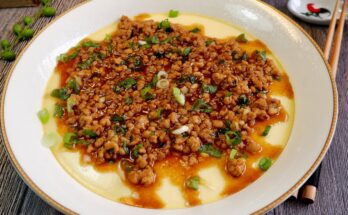Chicken Tamale Recipe: If you’ve never made tamales at home before, you’re in for a treat—and a bit of a workout. Chicken tamales are warm, comforting, and packed with savory flavor. Think of them as little flavor-packed presents wrapped in corn husks. There’s something deeply satisfying about unwrapping one, revealing the soft masa dough inside, bursting with a rich, tender chicken filling.
Now, you might be thinking, “Can I really make tamales from scratch?” Absolutely. It might seem intimidating at first glance, but once you break it down step by step, it’s totally manageable—and even fun! Making tamales is a cherished tradition in many Latin households, especially during the holidays. But hey, who says you have to wait until Christmas to enjoy them?
Whether you’re making them solo or turning it into a tamale-making party with friends or family, this guide will walk you through everything you need—from the ingredients to steaming techniques—so you can confidently make delicious, authentic chicken tamales right in your own kitchen.
Origin and Cultural Importance of Tamales
Tamales go way back—like ancient-civilizations-back. The earliest evidence of tamales dates to Mesoamerica as early as 8000 to 5000 BC. Aztecs and Mayans made them for warriors, feasts, and religious ceremonies. And over time, the humble tamale has become a staple of Mexican cuisine and many Latin cultures.
Traditionally made during holidays, family reunions, and special occasions, tamales represent community and togetherness. The process is often a team effort, called a “tamalada,” where families gather to assemble hundreds of tamales. It’s more than just food—it’s love wrapped in corn husks.
Even today, in many households, the smell of steaming tamales means it’s time to celebrate. And making them yourself gives you a deep appreciation for the history and heart behind every bite.
List of Ingredients You’ll Need
Let’s get down to the good stuff—ingredients! Here’s everything you’ll need to make mouthwatering chicken tamales.
For the Dough (Masa)
- 4 cups masa harina (corn flour for tamales)
- 2 tsp baking powder
- 1 ½ tsp salt
- 1 ½ cups chicken broth (use from cooked chicken if possible)
- 1 cup lard or vegetable shortening
For the Filling
- 3 cups cooked, shredded chicken (preferably boneless, skinless thighs for flavor)
- 1 white onion, finely chopped
- 2 cloves garlic, minced
- 1 tsp cumin
- Salt and pepper to taste
For the Sauce (Red Chile Sauce)
- 5 dried guajillo chiles, stemmed and seeded
- 2 dried ancho chiles, stemmed and seeded
- 1 tomato, chopped
- 2 garlic cloves
- 1 tsp oregano
- ½ tsp cumin
- Salt to taste
- 1 ½ cups chicken broth
For Assembling
- 30 dried corn husks (soaked in warm water)
- Large pot with a steaming rack or tamalera
Kitchen Tools and Equipment Required
Before you dive in, make sure your kitchen is tamale-ready. Here’s what you’ll need:
- Large mixing bowls
- Blender or food processor (for the sauce)
- Steamer or large pot with a steaming insert
- Tongs
- Knife and cutting board
- Clean dish towel or tamale press (optional)
- Measuring cups and spoons
- Stand mixer (optional, for mixing masa)
Trust me, having the right tools makes this process smoother and way less stressful. Don’t worry if you don’t have a fancy tamale steamer—any large pot with a steam rack works just fine.
Choosing the Right Chicken for Tamales
This might sound basic, but the type of chicken you choose makes a big difference. Boneless skinless chicken thighs are ideal—they’re flavorful, juicy, and shred easily. Breast meat works too, but it tends to be drier. The key is to cook it slowly and let it soak in all that delicious chile sauce.
Want a shortcut? Rotisserie chicken can work in a pinch, though it won’t be as rich as freshly cooked. If you’re going all-in, consider simmering your chicken with onions, garlic, and bay leaves for maximum depth of flavor. The bonus? You can use the broth in your masa later.
Step-by-Step Guide to Making Chicken Tamales
This is where the magic happens. Take a deep breath—we’re going in. Step by step, one tamale at a time.
Step 1: Preparing the Corn Husks
Soak dried corn husks in warm water for at least 30 minutes until soft and pliable. This makes them easy to fold and prevents tearing when wrapping the tamales.
Step 2: Cooking and Shredding the Chicken
Boil chicken breasts in salted water with onion and garlic until tender. Once cooked, shred the meat using two forks and set aside. Save the broth for the masa—it adds rich flavor.
Step 3: Making the Sauce
Blend tomatoes, chili peppers, garlic, cumin, and onion into a smooth sauce. Simmer in a pan for 10 minutes, add the shredded chicken, and cook until well coated and flavorful.
Step 4: Preparing the Masa (Dough)
In a bowl, beat masa harina with chicken broth, lard (or shortening), baking powder, and salt until fluffy and spreadable.
Step 5: Assembling the Tamales
Spread masa on the center of each husk, add a spoonful of chicken filling, and fold the sides and ends to seal.
Step 6: Steaming the Tamales
Place upright in a steamer and cook for 1 to 1½ hours until firm. Let rest before serving—authentic, tender, and full of flavor!
Tips for Perfect Chicken Tamales
Want to make sure your tamales turn out as good as grandma’s? Here are some no-fail tips:
- Whip your fat (lard or shortening) before adding masa harina. This step adds air, which makes the dough fluffier.
- Use warm broth to mix into the masa—it blends better and helps with texture.
- Don’t overfill the tamales—less is more. You need enough dough to seal the edges and hold everything together.
- Soak the husks long enough. Dry husks = cracked tamales.
- Test the masa in water. This is an old-school trick to know it’s ready.
- Steam gently and keep it moist. Dry heat or overheating can make the tamales tough and chewy.
Practice makes perfect. Even if your first batch isn’t Instagram-worthy, they’ll still taste incredible—and your next batch will be even better.
Common Mistakes to Avoid
Even pros mess up sometimes. Here are the usual suspects when tamales don’t go according to plan:
- Masa too dry or too wet: Too dry and it crumbles, too wet and it won’t cook. Aim for peanut butter consistency.
- Under-steaming: If your masa is gummy or stuck to the husk, steam them longer.
- Tamales laying flat: They might flatten or leak. Always stand them upright in the steamer.
- Forgetting the towel over the pot: This helps trap steam and cook them evenly.
- Not seasoning the filling: Don’t rely on the sauce alone—season every component.
Avoiding these common pitfalls will save you time and a lot of kitchen heartache.
How to Store and Reheat Tamales
Made a big batch? Perfect! Tamales store and reheat beautifully, which makes them ideal for meal prepping or freezing.
Refrigeration:
- Let tamales cool completely.
- Wrap in foil or plastic wrap and place in an airtight container.
- Store for up to 5-7 days in the fridge.
Freezing:
- Wrap each tamale individually in plastic wrap or foil.
- Place in a freezer-safe bag.
- Freeze for up to 3 months.
Reheating Instructions:
- Steamer (Best Option): Steam for 15-20 minutes (if refrigerated) or 25-30 minutes (if frozen).
- Microwave: Wrap in a damp paper towel and microwave for 1-2 minutes (refrigerated), or defrost first if frozen.
- Oven: Wrap in foil and bake at 350°F (175°C) for 20 minutes.
Tamales reheat like a dream, and some even say they taste better the next day.
What to Serve with Chicken Tamales
Tamales are pretty filling on their own, but adding a few sides and drinks can take the meal to a whole new level.
Great Side Dishes:
- Mexican rice or arroz rojo
- Refried beans or black beans
- Elote (Mexican street corn)
- Pico de gallo or salsa verde
- Guacamole and tortilla chips
Drinks That Pair Well:
- Horchata (sweet rice milk)
- Agua de jamaica (hibiscus tea)
- Mexican hot chocolate
- A cold cerveza or michelada
Want to go all out? Set up a tamale platter with multiple fillings and sides—it’s an instant fiesta.
Making Tamales for a Crowd
Tamales are perfect for large gatherings. In fact, it’s kind of their thing. Here’s how to scale up without losing your mind:
- Prep the filling and sauce a day ahead. It saves time and lets the flavors meld.
- Get help. Turn it into a tamalada—everyone gets a station: masa, filling, wrapping.
- Use multiple steamers or work in batches. You can even freeze raw, assembled tamales and steam them the day of.
Expect to make 30-40 tamales with this recipe. Just double or triple everything for larger crowds.
Are Chicken Tamales Healthy?
Let’s be honest—tamales aren’t exactly diet food. But they’re not junk food either. Here’s the breakdown:
- Protein-packed: Chicken gives you lean, quality protein.
- Carb-heavy: Masa is rich in carbs—great for energy, but watch the portion size.
- Fat content: Lard or shortening adds fat, but you can reduce it or use healthier alternatives like olive oil (though flavor may change).
- Fiber: Corn husks don’t add fiber, but pairing tamales with beans or salad helps balance the meal.
Want a lighter version? Use less lard, more lean meat, and pack in veggies like spinach, mushrooms, or zucchini.
Gluten-Free & Dairy-Free Options
Tamales are naturally gluten-free thanks to masa harina. But there are still a few things to watch out for:
- Check your masa harina label. Some brands process with gluten-containing grains.
- Use a gluten-free broth if buying store-bought.
- Go dairy-free by skipping cheese fillings or dairy-based sauces.
Swapping lard with vegan shortening or coconut oil can work if you’re going plant-based. Just know the texture may change slightly.
FAQs about Chicken Tamale Recipe
1. How long do tamales last in the fridge?
Tamales stay fresh in the refrigerator for up to 7 days. Just make sure they’re tightly wrapped to retain moisture.
2. Can I use rotisserie chicken for tamales?
Absolutely! It’s a great time-saver. Just shred it and mix with your homemade sauce.
3. Can tamales be made ahead of time?
Yes, and they’re actually better when made ahead! You can freeze them raw or cooked and reheat later.
4. How do I know when tamales are done steaming?
The masa should easily pull away from the husk and feel firm but soft. If it sticks, give them more time—usually 1.5 to 2 hours total.
5. What if I can’t find corn husks?
Banana leaves are a great substitute (popular in Central American tamales). You can also try parchment paper in a pinch.
Conclusion
Chicken tamales are more than just food—they’re a labor of love. From the soaking of corn husks to the final steam, every step is worth it for that first delicious bite. Making tamales at home might seem like a big task, but it’s also a deeply rewarding one. Whether it’s your first time or your fiftieth, each batch tells a story.
So, gather your ingredients, roll up your sleeves, and make some tamales. Trust me—your taste buds (and probably your neighbors) will thank you.



